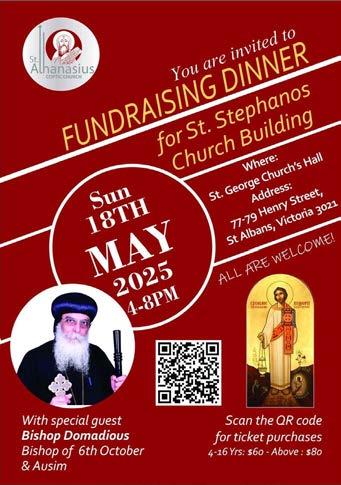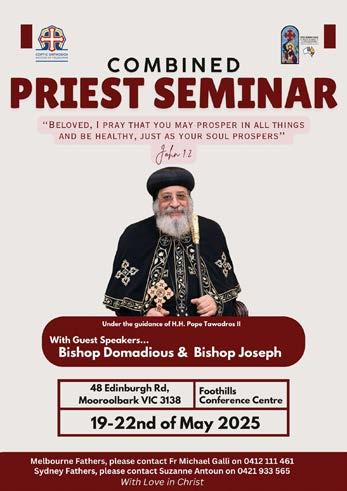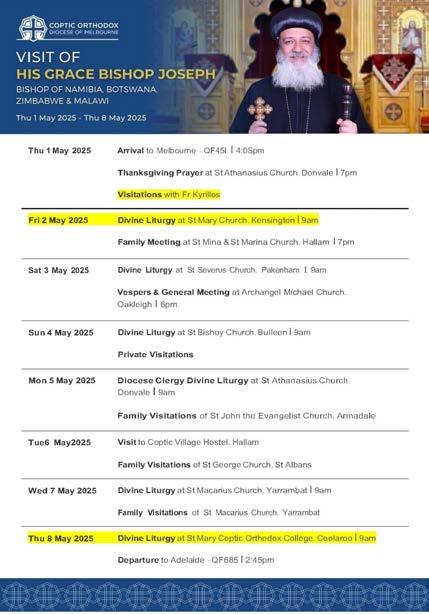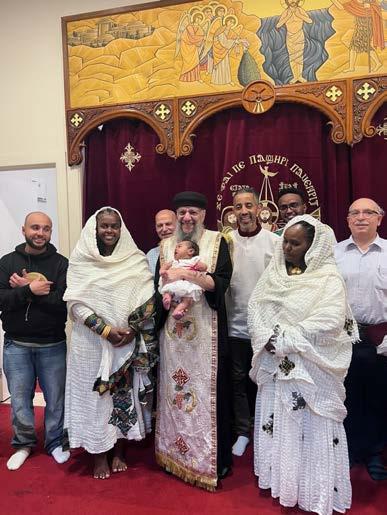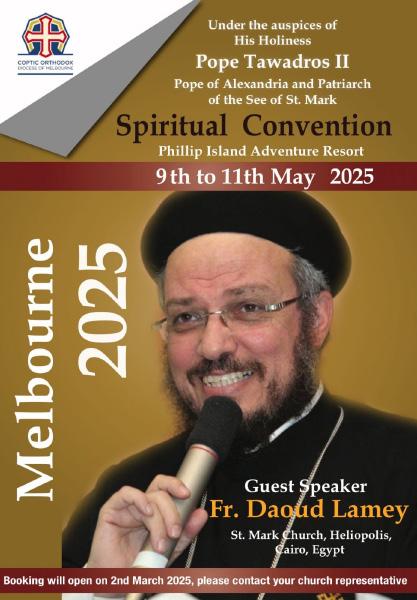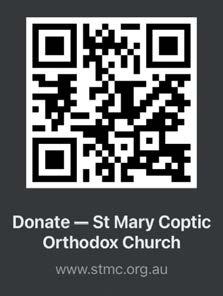
Services at St Mary’s Church
Monday:
Mass 8:30 - 11 AM
Tuesday
Liturgy 5:30 – 7 AM
The Way Orthodox Fellowship in English for adults - All ages 7:30 PM
Wednesday:
Mass 8:30 – 11 AM
Hymns class for adults 7 – 8:30 PM
English Bible Study 7:30 PM
Thursday
Mass 8:30 - 11 AM
English Midnight Praises 7:30 PM
Friday:
Mass 8:30 – 11 AM
Youth meeting 25 and above 7-9 PM
Discipleship Class 7-8:30 PM
Saturday:
Mass: 8:30 – 11 AM
Scouts 1:30 – 3 PM
Choirs and Theatre 2 – 4 PM
Vespers Praises 2:45 – 4 PM
Sunday School for grades 7-10 4 – 6:30 PM
Sunday School for primary 4:30 – 6 PM
Vespers & youth meeting 7-8:30pm English
Vespers &Bible Study Arabic 6-7:30 PM
Midnight Praises 7:30 – 9:30 PM
Sunday:
1st Mass 6:30 - 8:30 Arabic & English
2nd Mass.8:30 - 10:30 English - St Mary’s
Church
3rd Mass 8:30 - 10:30 Arabic - St John’s
Chrysostom
Psalmist School of Hymnology 11:15 AM –12:15 PM
Church Priests:
Fr Tadros Sharobeam 0414251251
Email: frtadros@me.com
Fr Habib Girgis Younan: 0401238177 – 94498871
Email: habibgirgisyounan@hotmail.com
Fr Michael Salib: 0422431821
Email: frmichael@sac.edu.au
Church Address: 5 Epsom Rd., Kensington Vic 3031 Tel: 93766651
Fr Kyrillos Tawadros 0411 518 399
Fr John Makary 0433 445 636
The Martyrdom of the Great Saint Mark, the Apostle
The Evangelist of the Land of Egypt.
8th May – 30th Baramoda
On this day, which coincided with the 26th. of April 68 A.D., the great apostle St. Mark, the evangelist of the land of Egypt, was martyred. He was the first Pope of Alexandria and one of the Seventy Apostles. His name was John, as the Holy Bible says: “He came to the house of Mary, the mother of John whose surname was Mark, where many were gathered together praying” )Acts 12:12(. He was the one that the Lord Acts 12:12( Christ, to Whom is the glory, meant when He said: “Go into the city to a certain man, and say to him, The Teacher says, My time is at hand; I will keep the Passover at your house with My disciples” )Matthew 26:18(. Matthew 26:18 His house was the first Christian church, where they ate the Passover, hid after the death of the Lord Christ, and in its upper room the Holy Spirit came upon them. This Saint was born in Cyrene )One of the Five WestWest ern cities, Pentapolis - in North Africa(. His father’s name was Aristopolus and his mother’s name was Mary. They were Jewish in faith, rich and of great honor. They educated him with the Greek and Hebrew cultures. He was called Mark after they emigrated to Jerusalem, where St. Peter had become a disciple to the Lord Christ. St. Peter was married to the cousin of Aristopolus. Mark visited St. Peter’s house often, and from him he learned the Christian teachings. Once Aristopolus and his son Mark were walking near the Jordan river, close by the desert, they encountered a raving lion and a lioness. It was evident to Aristopolus that it would be his end and the end of his Son, Mark. His compassion for his son compelled him to order him to escape to save himself. Mark answered, “Christ, in whose hands our lives are committed, will not let them prey on us.” Saying this, he prayed, “O, Christ, Son of God protect us from the evil of these two beasts and terminate their offspring from this wilderness.” Immediately, God granted this prayer, and the two beasts fell dead. His father marvelled and asked his son to tell him about the Lord Christ. He believed in the Lord Christ at the hands of his son who baptized him. After the ascension of the Lord Christ, he accompanied Paul and Barnabas to preach the Gospel in Antioch, Seleucia, Cyprus, Salamis, and Perga Pamphylia where he left them and returned to Jerusalem. After the Apostolic Council in Jerusalem, he went with Barnabas to Cyprus.
After the departure of Barnabas, with the order of the Lord Christ, St. Mark went to Afrikia, Berka, and the
Five Western cities. He preached the Gospel in these parts, and believed on his hands most of its people. From there, he went to Alexandria in the 1st. of Bashans 61 A.D.
When he entered the city, his shoe was torn because of the much walking in preaching and evangelism. He went to a cobbler in the city, called Anianus, to repair it. While he was repairing it the awl pierced his finger. Anianus shouted in Greek saying “EIS THEOS” which means “O, ONE GOD”. When St. Mark heard these words his heart rejoiced exceedingly. He found it suitable to talk to him about the One God. The Apostle took some clay, spat on it and applied it to Anianus’ finger, saying in the Name of Jesus Christ the Son of God, and the wound healed immediately, as if nothing happened to it.Moses, who brought the children of Israel out of Egypt, and gave them the Law, the captivity of the children of Israel to Babylon, and the prophecies that foretold the coming of Christ. Anianus invited him to go to his house and brought to him his children. The Saint preached and baptized them in the Name of the Father and the Son and the Holy Spirit.
When the believers in the Name of Christ increased and the pagan people of the city heard that, they were raged with anger and thought of slaying St. Mark. The faithful advised him to get away for a short while for the sake of the safety of the church and its care. St. Mark ordained St. Anianus a Bishop for Alexandria, three priests and seven deacons. He went to the Five Western Cities, remained there for two years preaching, and ordained bishops, priests, and deacons. He returned to Alexandria where he found the believers had increased in number and built a church for them in the place known as Bokalia )The place of cows(, east of Alexandria on the sea shore. ( It came to pass, when he was celebrating the feast of the Resurrection on the 29th day of Baramudah, year 68 A.D., the same day coincided with the great pagan Celebration for the feast of the god Syrabis, a multitude of them assembled and attacked the church at Bokalia and forced their way in. They seized St. Mark, bound him with a thick rope and dragged him in the roads and streets crying, “Drag the dragon to the place of Cows.” They continued dragging him with severe cruelty. His flesh was torn and scattered everywhere, and the ground of the city was covered with his blood. They cast him that night into a dark prison. The angel of the Lord appeared to him and told him: “O Mark, the good servant, rejoice for your name has
been written in the book of life, and you have been counted among the congregation of the saints.” The angel disappeared, then the Lord Christ appeared to him, and gave him peace. His soul rejoiced and was glad.
The next morning )30th of Baramudah(, the pagans took St. Mark from the prison. They tied his neck with a thick rope and did the same as the day before, dragging him over the rocks and stones. Finally, St. Mark delivered up his pure soul in the hand of God, and received the crown of martyrdom, the apostolic crown, the crown of evangelism, and the crown of virginity.
Nevertheless, St. Mark’s death did not satisfy the rage of the pagans and their hatred. They gathered much firewood and prepared an inferno to burn him. A severe storm blew and heavy rains fell. The pagans became frightened, and they fled away in fear. The believers came and took the holy body, carried it to the church they built at Bokalia, wrapped it up, prayed over him and place it in a coffin. They laid it in a secret place in this church. The prayers of this great Saint and honorable Evangelist be with us and Glory be to our God forever. Amen. The Nativity of the Blessed Virgin Mary The Mother of God.
9th May – 1st Bashans
On this day the church celebrates the birth of the pure Virgin St. Mary, the Mother of God )Theotokos(, ) ( through whom Salvation came to mankind. She was born in the city of Nazareth, where her parents lived. Her father was grieved in his heart for he could not offer an offering to God for he did not have any children. In the fullness of time according to the Divine Will, the angel of the Lord was sent to announce Joachim, her father, while he was on the mountain praying, and said to him: “The Lord will give you offspring through whom salvation comes to the world.” Immediately he went down the mountain believing what the angel told him, and he told his wife Anna of what he saw and heard. She rejoiced, gave thanks to the Lord, and vowed that the child who was to be born to her would become a servant in the house of the Lord all the days of her/his life. She conceived, and gave birth to this Saint and called her Mary who had become the Queen of all women of the world, and through her we have received the grace. May her intercession be with us, and glory be to God forever. Amen.
Second Sunday Pentecost
The second Sunday of the Holy Pentecost and the Gospel of the Mass )John 6: 35-45( The world is by its very nature perishes; everything in it is destroyed, everything in it passes away. The world destroys itself and destroys those in it and all the things in it. The world is full of museums and relics of those who preceded us and it witnesses to us how they built great civilizations for themselves and then they disappeared and were destroyed and finished. What remained of them was nothing but stones and remnants, and those who built them disappeared under piles of dirt, and nothing is known about them. If we counted the number of people who were born on this earth since the beginning of creation until now, and we imagined that each of them left one handful of dust, we would discover that all the dust present on earth today must be these bodies that died and were transformed into this dust. The strange thing is that the human being walks on the bodies of those who preceded him and builds homes and buildings using the remains of these bodies. We live in a world that demolishes in order to build and build to demolish.
The world gives us earthly food and we turn it into waste and decay. As for the Lord, He gives us heavenly bread that does not perish and makes us imperishable. Those in the hand of God are not destroyed, and even if their bodies are destroyed, their souls are not, rather they have eternal life. Beloved, if you want to survive this global damage, then you must have food that does not perish.
+ Bread of life ++++++++
It is the bread that does not perish and whoever eats of it will never perish but whoever shun from it will surely perish. The manna that the Lord gave to the children of Israel in the wilderness was sufficient to support them for forty years.
Half a piece of bread the Lord ordered the
raven to feed Anba Paul every day, and he lived on it for seventy years, without seeing a human face.
Put all these things in the standards of the world and they worth nothing, but in the standards of God give life. There are those who have taken care of the world›s bread and got tired. There are those who think that money makes everything and for money›s sake they leave their own salvation and the salvation of their family, so what did they gain? We hear about a rich man who had buildings and mansions and he used to live in a simple apartment and this apartment was tumbling-down. His children tried to convince him to take him to an elegant and beautiful place, especially because he was sick, but he always refused until the building in which he lived fell and died under the rubble. His children discovered that he was hiding jewellery in the wall of the old apartment, and he did not want to leave it, and so he remained next to it until he died beside it.
The bread of the world causes decay and worry. You have tried the bread of the world and have not benefited anything. So why do not you try the heavenly bread. It is guaranteed that whoever eats it will never perish, but will have eternal life.
The heavenly bread is the Word of God, the one who gives you life, it is the body and blood of the Lord, whoever eats from it will have eternal life. The saints deprived themselves of the earth›s bread for the sake of heavenly bread, so they rejoiced and attained the promises of heaven.
+ Everyone who sees the Son and believes in Him may have everlasting
life
The time will come when the human eye is turned off and not seen, but you can make it see the light of heaven and does
not perish. The eye that looks at the earthly becomes dust; the eye that looks at the views of the world is infected with world diseases. If you want to protect your eyes, make them look at the heaven, meditate on the cross; meditate on the crucified Christ Who is crowned with thorns. Let your eyes live in heaven. How do you make your tongue not get damaged? Make it utter the word of God; make it not utter the word idleness. How do you invest your ears to heaven? Did you make it hear the sounds of praise, chanting and prayers, or the world›s songs? Is your time wasted; perishable time? Or you have invested it for the sake of heaven? Imagine your life on earth as just a few seconds, no matter how long your days on earth are, it is very short compared to eternity. Educate yourself to spend your time in the life of holiness and righteousness. A person who cannot stand the moments of praising and holy life, how can he be keen for eternity which is lived solely in praising and glorifying the name of God? Whoever does not practice his holy life here, how does he practice it in Heaven? Beloved, redeem your time, redeem the whole life, redeem time, because the days are short and evil. Have you made for yourself friends who will not perish in the afterlife? Or are you keen to have friends on earth only? Friends of the Earth quickly disappear, and soon dust folds them. Where are your permanent friends? Do you have friends from the angels? Do you have saints friends? Everything that is in the hand of God is never destroyed, rather it succeeds and advances, and from it eternal life and the Lord will raise it on the last day. The Lord Jesus is the bread of life, he who comes to Him will not get hungry and he who believes in Him is never thirsty.

